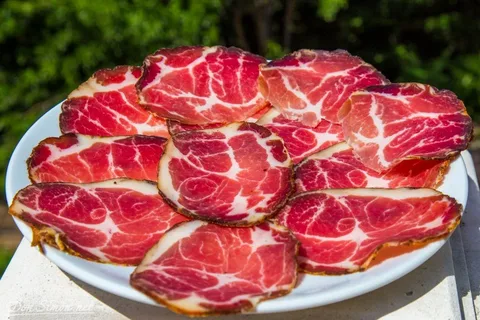Introduction
Hundreds of different types of salumi are produced in Italy using one of two methods. The first uses whole cuts of meat, which get liberally salted and aged for several months, while the second involves combining different meaty bits, which get seasoned and placed in a casing before aging. One of the former types of cured meat is the popular variety known as capicola, or gabagool if you happen to be a fan of the popular television series “The Sopranos.”
We wanted to know more about this delicacy Tony Soprano couldn’t get enough of, how to eat it, and where to find it. Let’s look at the origins and elaborate production involved in making one of Italy’s finest examples of cured meat — capicola.
What is capicola?
Capicola is a pork-based deli meat from Italy that comes from the same family as ham and prosciutto. The name is an amalgamation of two Italian words: capo, meaning head, and colla, meaning neck; this references the cut of meat from a pig that runs along the neck until the fourth rib.
The standard ham can be prepared a number of ways: dry cured, wet cured or brined, or smoked. Capicola is always dry cured. The meat is seasoned with wine, garlic, and a variety of spices depending on where it is made. It is then salted and allowed to dry for around six months.

Sliced thin, capicola is a staple of the Italian submarine in Philadelphia and a common sight in most deli counters throughout the United States.Depending on its origin.
Types of Capocollo
There are seven main varieties of capocollo, each with their own slightly different recipe;
Coppa Piacentina: this capocollo has an EU Protected Designation of Origin (PDO), meaning anything bearing the name must originate in Piacenza. The traditional recipe uses seasonings of salt, pepper, cloves, and cinnamon.
Capocollo di Calabria: this product is the second out of the two capocollo products to hold an EU PDO, and it can only be produced in the Calabria region of Italy. Capicola di Calabria is traditionally seasoned with vinegar and black peppercorns.
Capocollo della Basilicata: this capocollo comes from the Basilicata region of southern Italy. The product uses neck meat, and it has a deep red color due to its (sweet or spicy) chili pepper seasoning.
Capocollo del Lazio: from the region of Lazio in the Central area of Italy.
Capocollo di Martina Franca: This capocollo originates in the town of Martina Franca, located in the Apulia region of southern Italy. This recipe involves soaking in salt for 15-20 days and seasonings such as thyme, laurel, and oak bark with a distinctive rosy color.
How to Make Capicola
Cooking this Italian dish from home takes time and requires a lot of patience. If you’re short on time, buying from a store is an excellent choice. However, if you’re ready for the task and the eventual payoff, remain tuned. The simplest approach is to marinate pork neck and shoulder in a garlic, herb, wine, and spice mixture. Apply a salt rub to the meat before vacuum-sealing and refrigerating it for several weeks.
Then, wash off the salt and flavor the meat again with a spice rub containing black pepper, red pepper, fennel, paprika, and coriander. Place the seasoned beef in either collagen sheets or vacuum-sealed dry age bags. Finally, hang it. Place the soon-to-be cured beef in a temperature-controlled fridge or room and let it dry for up to six months. Once this process is completed, you can enjoy the benefits of your labor and a well-deserved cold cut. If you like it, you can mature your cured meat by allowing it to age or ripen after the first curing procedure.
What Makes Capicola So Unique?
In Italy, Capicola is sometimes called Capocollo. It is a mix of capo and collo, which signify head and neck. Outside of Italy, it is commonly known as coppa or capicola. So, One unusual variety is the Italian-American of New York’s use of “gabagool” This variant was used by Tony Soprano in the TV series The Sopranos.
Officially, it comes from the Italian, cities of Calabria and Piacenza. Amazingly, the European Union granted the cured beef the Protected Designation of Origin (PDO).
How Does It Taste?
Capocollo has a soft and tender texture, is slightly chewy, and has a fatty, salty, and spicy taste.
However, the herbs and spices are not overpowering and add a delicate flavor.
The flavor can differ from product to product, as the herbs and spices used in the production vary between Italian regions.
What to Serve with Capicola?
There are several ways to enjoy capicola. The most typical method is to prepare a charcuterie board or an Italian sub. You can try capicola and prosciutto this way and see which one you like.
These meats match well with a variety of cheeses, including provolone, gruyere, and cheddar, as well as green and black olives and crusty bread, such as ciabatta.
You can also use thinly sliced capicola as a topping for homemade pizzas, along with salami, roasted tomatoes, mozzarella, and hot peppers, for a flavour boost.
Capicola is a dried meat that is safe to eat uncooked. Without cooking it, you can munch on it if you want to try it out!
Conclusion
The capicola taste profile is a distinct flavor that you will love. However, Capocollo will change your meals for the better when you start using it!. Try different recipes with a range of ingredients to experiment with your Coppa.
